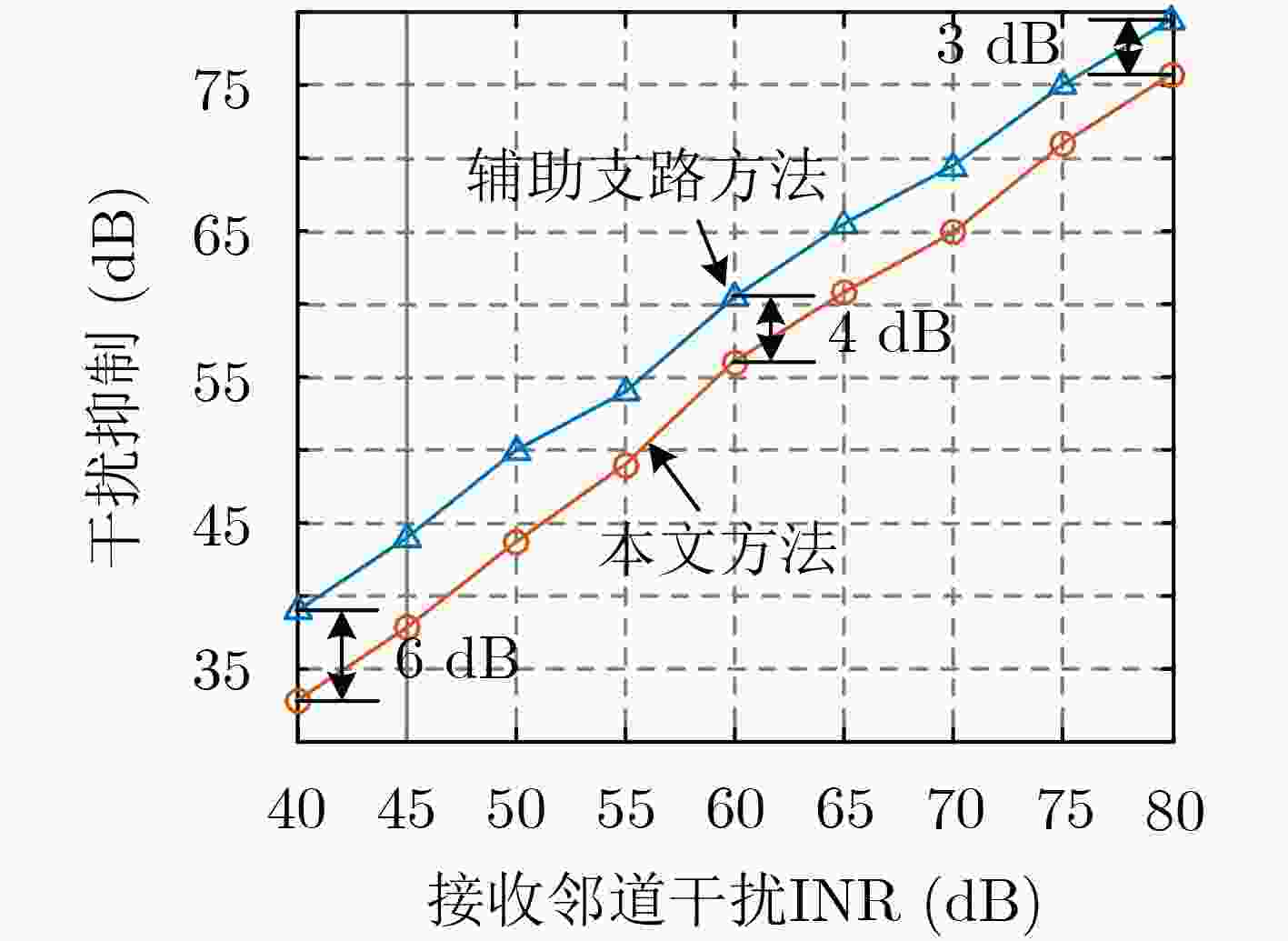Adjacent Channel Interference Suppression Based on Deconvolution of Interference Signal’s Out-of-band Component
-
摘要: 邻道干扰(ACI)抑制中需要获取干扰信号非线性特征进行信号重建与抵消,因此接收机需使用高速率宽带模数转换器(ADC)采集干扰信号,这将大幅增加接收机成本。针对上述问题,该文提出一种采用干扰信号带外分量卷积反演的邻道干扰抑制方法,利用接收的干扰信号带外非线性分量,计算并消除相邻帧之间的影响,由窄带部分卷积信号帧构造出线性卷积信号帧,然后用正则化最小二乘方法恢复原始非线性宽带干扰信号,从而降低ADC采样率。仿真验证结果表明当采样率仅为传统方案1/3,所提方法带来的残余干扰不高于底噪6 dB。Abstract: In Adjacent Channel Interference (ACI) suppression, in order to obtain the nonlinear characteristics of interference signal for reconstruction and cancellation, the receiver needs to use high-sampling-rate wideband Analog-to-Digital Converter (ADC) to sample interference signal, which will greatly increase the cost of the receiver. To solve the problem, a ACI suppression method based on deconvolution of interference signal’s out-of-band component is proposed in this paper. By using the known out-of-band nonlinear component, the influence between adjacent frames is calculated and eliminated, and then the narrow band linear convolution frame is constructed from the partial convolution frame. Finally, the original wide band signal is recovered by regularized least square method, thus reducing the ADC sampling rate. The simulation results show that when the sampling rate is only 1/3 of the traditional scheme, the residual interference brought by the proposed method is not higher than the noise floor of 6 dB.
-
表 1 仿真实验参数设置
项目指标 参数值 信号帧长 2.56 ms 信号带宽 25 kHz 滤波器阶数 60 采样频率 125 kHz 阻带频率1/通带频率1 20/30 kHz 通带频率2/阻带频率2 50/60 kHz 阻带衰减 50 dB 表 2 仿真系统参数设置
项目指标 参数值 信号带宽 25 kHz 信道带宽 50 kHz 发射功率 18 dBm 干扰信号SNR 70~110 dB 邻道干扰INR 40~80 dB -
ZHOU Ping, LU Yinghua, TAO Yong, et al. Simulation analysis on co-site interference of vehicular digital communication system based on IM prediction method by BER[J]. The Journal of China Universities of Posts and Telecommunications, 2016, 23(1): 31–41. doi: 10.1016/S1005-8885(16)60005-5 HAN Ting, HAN Bingjun, ZHANG Lin, et al. Coexistence study for wifi and zigbee under smart home scenarios[C]. IEEE International Conference on Network Infrastructure and Digital Content, Beijing, China, 2012: 669-674. doi: 10.1109/ICNIDC.2012.6418840. IEEE. IEEE 802.11-2007 Wireless LAN medium access control (MAC) and physical layer (PHY) specifications[S]. IEEE, 2007. NIKITIN A V, DAVIDCHACK R L, and SMITH J E. Out-of-band and adjacent-channel interference reduction by analog nonlinear filters[J]. EURASIP Journal on Advances in Signal Processing, 2015, 2015(1): 12. doi: 10.1186/s13634-015-0202-5 刘建成, 全厚德, 孙慧贤, 等. 近距离无线电台邻道干扰的功率谱解析[J]. 电讯技术, 2017, 57(3): 306–310. doi: 10.3969/j.issn.1001-893x.2017.03.010LIU Jiancheng, QUAN Houde, SUN Huixian, et al. Power spectrum resolution of adjacent channel interference for collocated wireless radios[J]. Telecommunication Engineering, 2017, 57(3): 306–310. doi: 10.3969/j.issn.1001-893x.2017.03.010 武南开, 苏东林, 何洪涛, 等. 机载超短波电台邻道干扰减敏特性建模与评估[J]. 北京航空航天大学学报, 2017, 43(3): 481–487. doi: 10.13700/j.bh.1001-5965.2016.0230WU Nankai, SU Donglin, HE Hongtao, et al. Adjacent channel interference modeling and assessment on reduction of airborne VHF radio sensitivity[J]. Journal of Beijing University of Aeronautics and Astronautics, 2017, 43(3): 481–487. doi: 10.13700/j.bh.1001-5965.2016.0230 XUE Zhen, WANG Jinlong, SHI Qingjiang, et al. Time-frequency scheduling and power optimization for reliable multiple UAV communications[J]. IEEE Access, 2018, 6: 3992–4005. doi: 10.1109/ACCESS.2018.2790933 霍晓磊, 赵宏志, 刘颖, 等. 基于抵消技术的邻道干扰抑制[J]. 系统工程与电子技术, 2019, 41(11): 2611–2618.HUO Xiaolei, ZHAO Hongzhi, LIU Ying, et al. Adjacent channel interference suppression based on cancellation technology[J]. Systems Engineering and Electronics, 2019, 41(11): 2611–2618. ROBLIN P, QUINDROIT C, NARAHARISETTI N, et al. Concurrent linearization: The state of the art for modeling and linearization of multiband power amplifiers[J]. IEEE Microwave Magazine, 2013, 14(7): 75–91. doi: 10.1109/MMM.2013.2281297 LIU Ying, HUANG Chuang, QUAN Xin, et al. Novel linearization architecture with limited ADC dynamic range for green power amplifiers[J]. IEEE Journal on Selected Areas in Communications, 2016, 34(12): 3902–3914. doi: 10.1109/JSAC.2016.2600415 LIU Ying, PAN Wensheng, SHAO Shihai, et al. A new digital predistortion for wideband power amplifiers with constrained feedback bandwidth[J]. IEEE Microwave and Wireless Components Letters, 2013, 23(12): 683–685. doi: 10.1109/LMWC.2013.2284786 MA Yuelin, YAMAO Y, AKAIWA Y, et al. Wideband digital predistortion using spectral extrapolation of band-limited feedback signal[J]. IEEE Transactions on Circuits and Systems I: Regular Papers, 2014, 61(7): 2088–2097. doi: 10.1109/TCSI.2013.2295897 PAN Wensheng, LIU Ying, SHAO Shihai, et al. A method to reduce sampling rate of the ADC in feedback channel for wideband digital predistortion[J]. Circuits, Systems, and Signal Processing, 2014, 33(8): 2655–2665. doi: 10.1007/s00034-014-9751-3 LIU Ying, PAN Wensheng, SHAO Shihai, et al. A general digital predistortion architecture using constrained feedback bandwidth for wideband power amplifiers[J]. IEEE Transactions on Microwave Theory and Techniques, 2015, 63(5): 1544–1555. doi: 10.1109/TMTT.2015.2416184 YU Xin. Digital predistortion using feedback signal with incomplete spectral information[C]. 2012 Asia Pacific Microwave Conference, Kaohsiung, China, 2012: 950–952. doi: 10.1109/APMC.2012.6421788. 邹谋炎. 反卷积和信号复原[M]. 北京: 国防工业出版社, 2001: 10-160.ZOU Mouyan. Deconvolution and Signal Recovery[M]. Beijing: National Defense Industry Press, 2001: 10-160. HANSEN P C. Analysis of discrete ill-posed problems by means of the L-curve[J]. SIAM Review, 1992, 34(4): 561–580. doi: 10.1137/1034115 GOLUB G H, HEATH M, and WAHBA H G. Generalized cross-validation as a method for choosing a good ridge parameter[J]. Technometrics, 1979, 21(2): 215–223. doi: 10.1080/00401706.1979.10489751 HANSEN P C. REGULARIZATION TOOLS: A matlab package for analysis and solution of discrete ill-posed problems[J]. Numerical Algorithms, 1994, 6(1): 1–35. doi: 10.1007/BF02149761 DING Lei, ZHOU G T, MORGAN D R, et al. A robust digital baseband predistorter constructed using memory polynomials[J]. IEEE Transactions on Communications, 2004, 52(1): 159–165. doi: 10.1109/TCOMM.2003.822188 -






 下载:
下载:








 下载:
下载:
